Analysis of HRM Issues and Solutions for Uber Technologies
VerifiedAdded on 2023/01/17
|11
|2645
|98
Report
AI Summary
This report provides a comprehensive analysis of Uber Technologies' Human Resource Management (HRM) practices, organizational structure, and the challenges it faces in a global context. The report begins with an introduction to Uber and its services, followed by an overview of international HRM concepts. It then delves into the specific HRM issues within Uber, including employee discrimination, sexual harassment scandals, and issues related to virtual teams and diversity management. The report examines Uber's global network and organizational structure, its approach to virtual teams and diversity management, and the culture shock experienced by its employees and drivers. Furthermore, it explores the Hofstede cultural model and its relevance to Uber's challenges. The report concludes with recommendations for improving HRM practices and addressing the identified issues, aiming to foster a more inclusive and effective work environment for Uber's global workforce. The report utilizes relevant literature, including studies and reports on Uber, to support its analysis and recommendations.
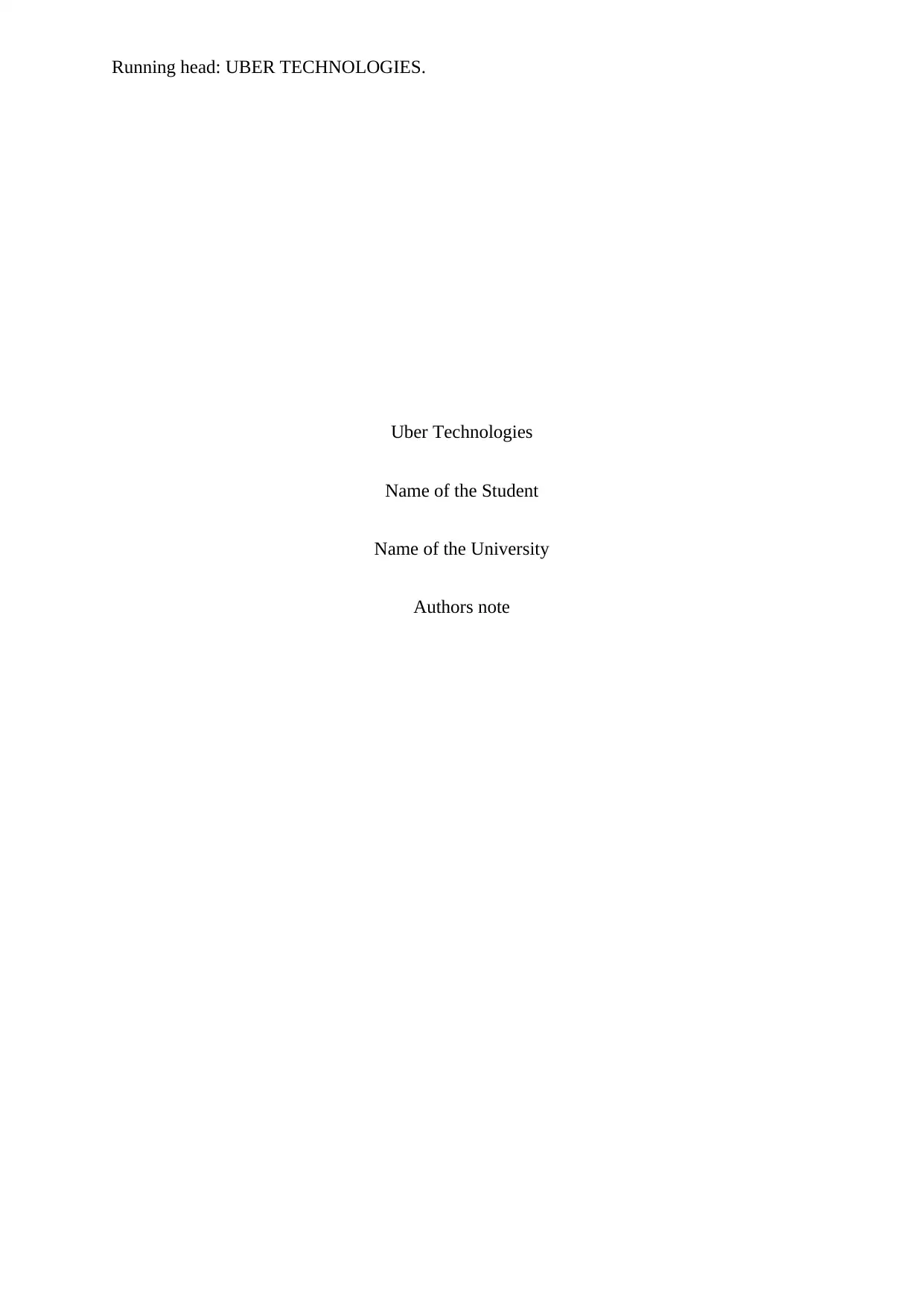
Running head: UBER TECHNOLOGIES.
Uber Technologies
Name of the Student
Name of the University
Authors note
Uber Technologies
Name of the Student
Name of the University
Authors note
Paraphrase This Document
Need a fresh take? Get an instant paraphrase of this document with our AI Paraphraser
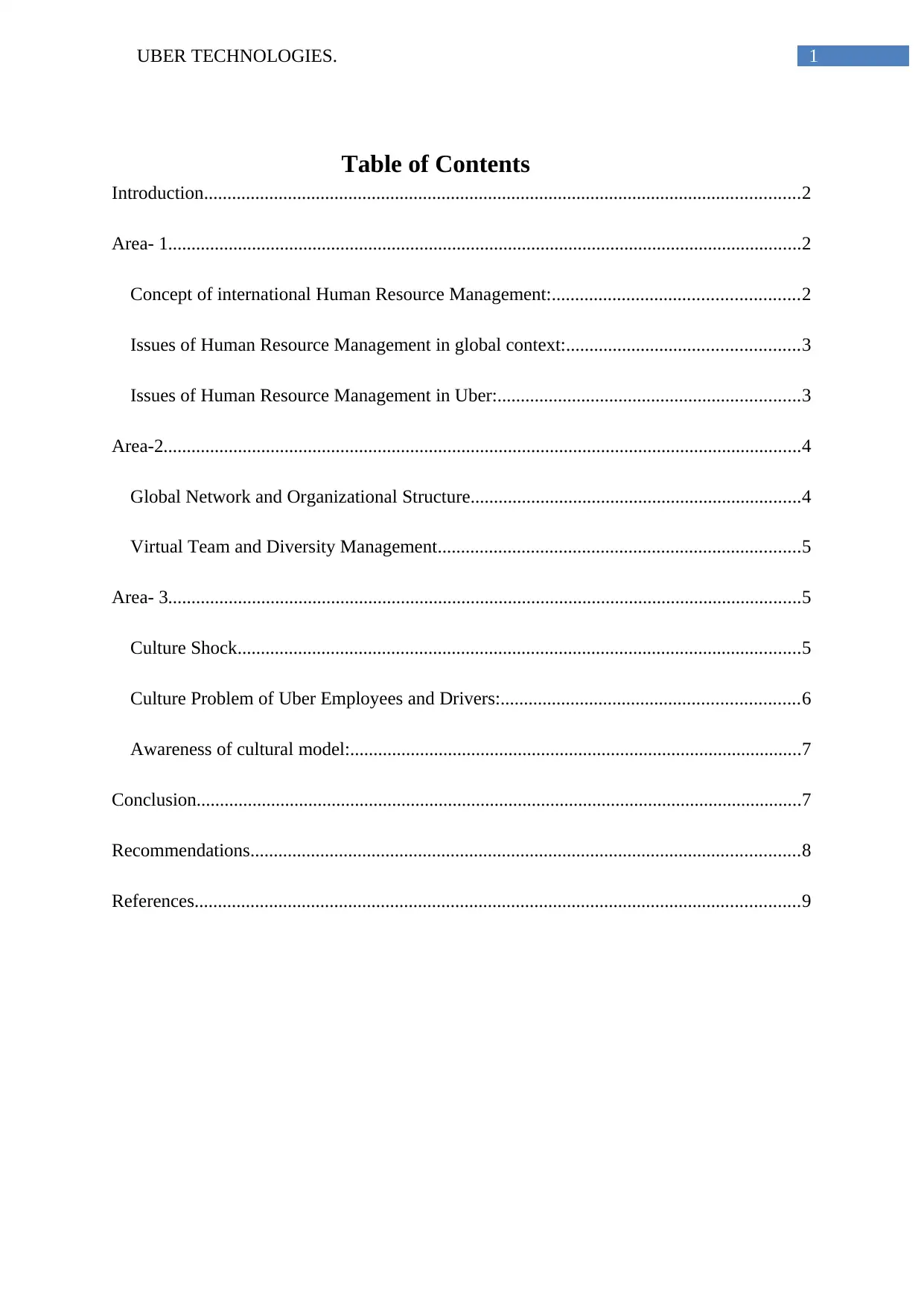
1UBER TECHNOLOGIES.
Table of Contents
Introduction................................................................................................................................2
Area- 1........................................................................................................................................2
Concept of international Human Resource Management:.....................................................2
Issues of Human Resource Management in global context:..................................................3
Issues of Human Resource Management in Uber:.................................................................3
Area-2.........................................................................................................................................4
Global Network and Organizational Structure.......................................................................4
Virtual Team and Diversity Management..............................................................................5
Area- 3........................................................................................................................................5
Culture Shock.........................................................................................................................5
Culture Problem of Uber Employees and Drivers:................................................................6
Awareness of cultural model:.................................................................................................7
Conclusion..................................................................................................................................7
Recommendations......................................................................................................................8
References..................................................................................................................................9
Table of Contents
Introduction................................................................................................................................2
Area- 1........................................................................................................................................2
Concept of international Human Resource Management:.....................................................2
Issues of Human Resource Management in global context:..................................................3
Issues of Human Resource Management in Uber:.................................................................3
Area-2.........................................................................................................................................4
Global Network and Organizational Structure.......................................................................4
Virtual Team and Diversity Management..............................................................................5
Area- 3........................................................................................................................................5
Culture Shock.........................................................................................................................5
Culture Problem of Uber Employees and Drivers:................................................................6
Awareness of cultural model:.................................................................................................7
Conclusion..................................................................................................................................7
Recommendations......................................................................................................................8
References..................................................................................................................................9
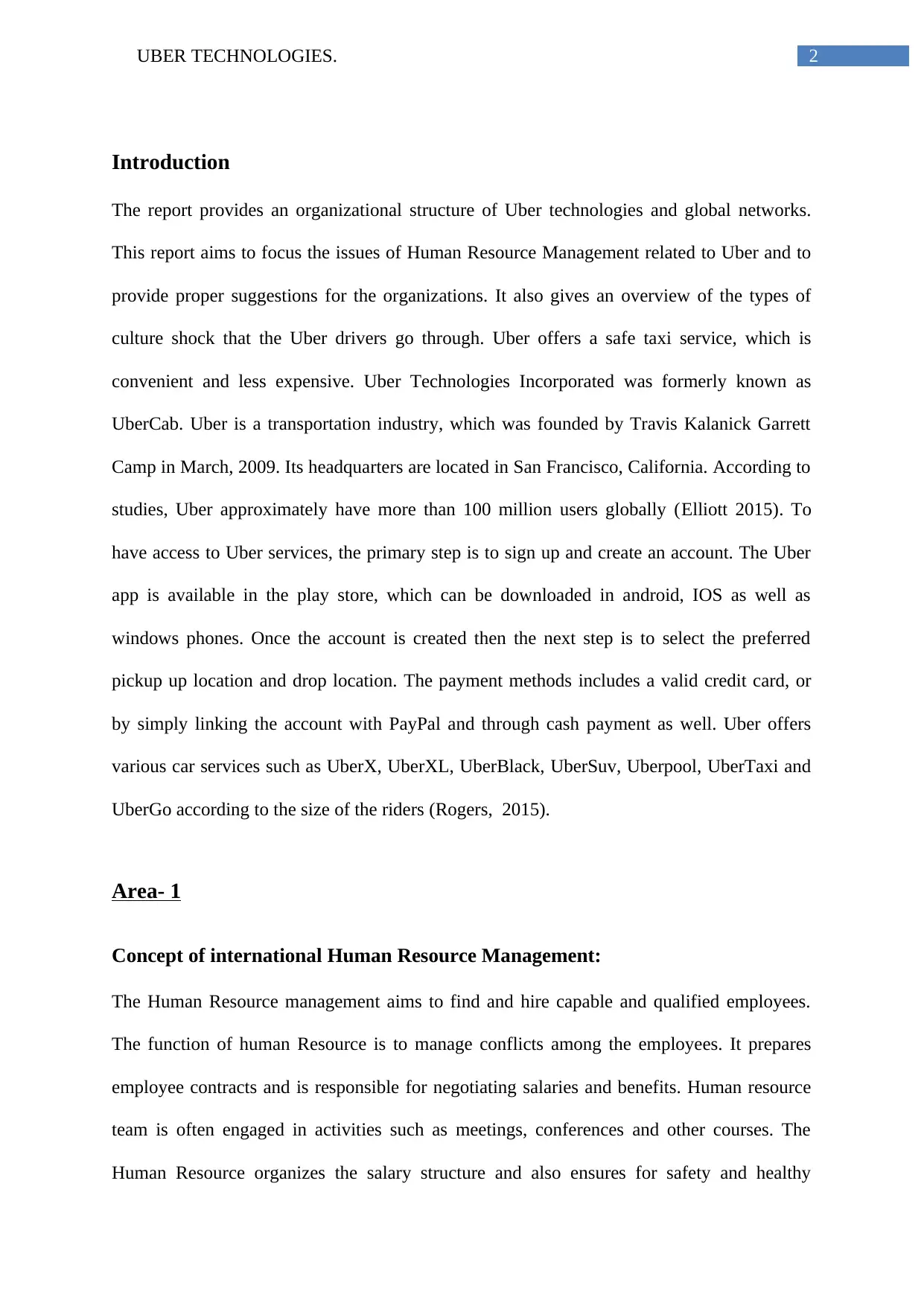
2UBER TECHNOLOGIES.
Introduction
The report provides an organizational structure of Uber technologies and global networks.
This report aims to focus the issues of Human Resource Management related to Uber and to
provide proper suggestions for the organizations. It also gives an overview of the types of
culture shock that the Uber drivers go through. Uber offers a safe taxi service, which is
convenient and less expensive. Uber Technologies Incorporated was formerly known as
UberCab. Uber is a transportation industry, which was founded by Travis Kalanick Garrett
Camp in March, 2009. Its headquarters are located in San Francisco, California. According to
studies, Uber approximately have more than 100 million users globally (Elliott 2015). To
have access to Uber services, the primary step is to sign up and create an account. The Uber
app is available in the play store, which can be downloaded in android, IOS as well as
windows phones. Once the account is created then the next step is to select the preferred
pickup up location and drop location. The payment methods includes a valid credit card, or
by simply linking the account with PayPal and through cash payment as well. Uber offers
various car services such as UberX, UberXL, UberBlack, UberSuv, Uberpool, UberTaxi and
UberGo according to the size of the riders (Rogers, 2015).
Area- 1
Concept of international Human Resource Management:
The Human Resource management aims to find and hire capable and qualified employees.
The function of human Resource is to manage conflicts among the employees. It prepares
employee contracts and is responsible for negotiating salaries and benefits. Human resource
team is often engaged in activities such as meetings, conferences and other courses. The
Human Resource organizes the salary structure and also ensures for safety and healthy
Introduction
The report provides an organizational structure of Uber technologies and global networks.
This report aims to focus the issues of Human Resource Management related to Uber and to
provide proper suggestions for the organizations. It also gives an overview of the types of
culture shock that the Uber drivers go through. Uber offers a safe taxi service, which is
convenient and less expensive. Uber Technologies Incorporated was formerly known as
UberCab. Uber is a transportation industry, which was founded by Travis Kalanick Garrett
Camp in March, 2009. Its headquarters are located in San Francisco, California. According to
studies, Uber approximately have more than 100 million users globally (Elliott 2015). To
have access to Uber services, the primary step is to sign up and create an account. The Uber
app is available in the play store, which can be downloaded in android, IOS as well as
windows phones. Once the account is created then the next step is to select the preferred
pickup up location and drop location. The payment methods includes a valid credit card, or
by simply linking the account with PayPal and through cash payment as well. Uber offers
various car services such as UberX, UberXL, UberBlack, UberSuv, Uberpool, UberTaxi and
UberGo according to the size of the riders (Rogers, 2015).
Area- 1
Concept of international Human Resource Management:
The Human Resource management aims to find and hire capable and qualified employees.
The function of human Resource is to manage conflicts among the employees. It prepares
employee contracts and is responsible for negotiating salaries and benefits. Human resource
team is often engaged in activities such as meetings, conferences and other courses. The
Human Resource organizes the salary structure and also ensures for safety and healthy
⊘ This is a preview!⊘
Do you want full access?
Subscribe today to unlock all pages.

Trusted by 1+ million students worldwide

3UBER TECHNOLOGIES.
environment (Nankervis et al. 2016). The Human Resource is also responsible to terminate
the employee from an organization for various reasons.
It is estimated that Uber technology Inc. comprises of 3000 employees, which appears to be
comparatively less for the company, which is currently serving in 311 cities (Calo and
Rosenblat 2017). The Human Resource of Uber provides proper instructions for the
workforce and identifies training requirements for business units. The Human Resource
builds strategic goals to increase the competitive advantages.
Issues of Human Resource Management in global context:
There are various challenges that a Human Resource management faces. The organization
needs to recruit the best talent that which will increase the operation of the company. The
HRM faces great pressure to examine the best candidate. If the HRM fails to select an
eligible employee then it will affect the productivity of the organization. The HRM has the
responsibility to provide proper training to the employees (Festing et al. 2013) Sometimes, it
is difficult to provide proper training for the group of people simultaneously. The HRM often
fails to maintain the productivity level of the company.
Issues of Human Resource Management in Uber:
According to the reports, the Human Resource Management of Uber was not properly
helping their people. The report further said that the department was unorganized and wasted
and also there were no availability of any senior support (Hohenstein, Feisel and Hartmann
2014). The employees were discriminated and unequally treated. The sexual harassment
scandal is one of the major issue faced by the Human resource Management of Uber.
According to the researches, Uber drivers sexually assaulted women and also forced them to
stay silent and resolve their claims not in the court but behind the doors. Women from
various cites has joined the case in order to represent all the rape victims. However, the
environment (Nankervis et al. 2016). The Human Resource is also responsible to terminate
the employee from an organization for various reasons.
It is estimated that Uber technology Inc. comprises of 3000 employees, which appears to be
comparatively less for the company, which is currently serving in 311 cities (Calo and
Rosenblat 2017). The Human Resource of Uber provides proper instructions for the
workforce and identifies training requirements for business units. The Human Resource
builds strategic goals to increase the competitive advantages.
Issues of Human Resource Management in global context:
There are various challenges that a Human Resource management faces. The organization
needs to recruit the best talent that which will increase the operation of the company. The
HRM faces great pressure to examine the best candidate. If the HRM fails to select an
eligible employee then it will affect the productivity of the organization. The HRM has the
responsibility to provide proper training to the employees (Festing et al. 2013) Sometimes, it
is difficult to provide proper training for the group of people simultaneously. The HRM often
fails to maintain the productivity level of the company.
Issues of Human Resource Management in Uber:
According to the reports, the Human Resource Management of Uber was not properly
helping their people. The report further said that the department was unorganized and wasted
and also there were no availability of any senior support (Hohenstein, Feisel and Hartmann
2014). The employees were discriminated and unequally treated. The sexual harassment
scandal is one of the major issue faced by the Human resource Management of Uber.
According to the researches, Uber drivers sexually assaulted women and also forced them to
stay silent and resolve their claims not in the court but behind the doors. Women from
various cites has joined the case in order to represent all the rape victims. However, the
Paraphrase This Document
Need a fresh take? Get an instant paraphrase of this document with our AI Paraphraser
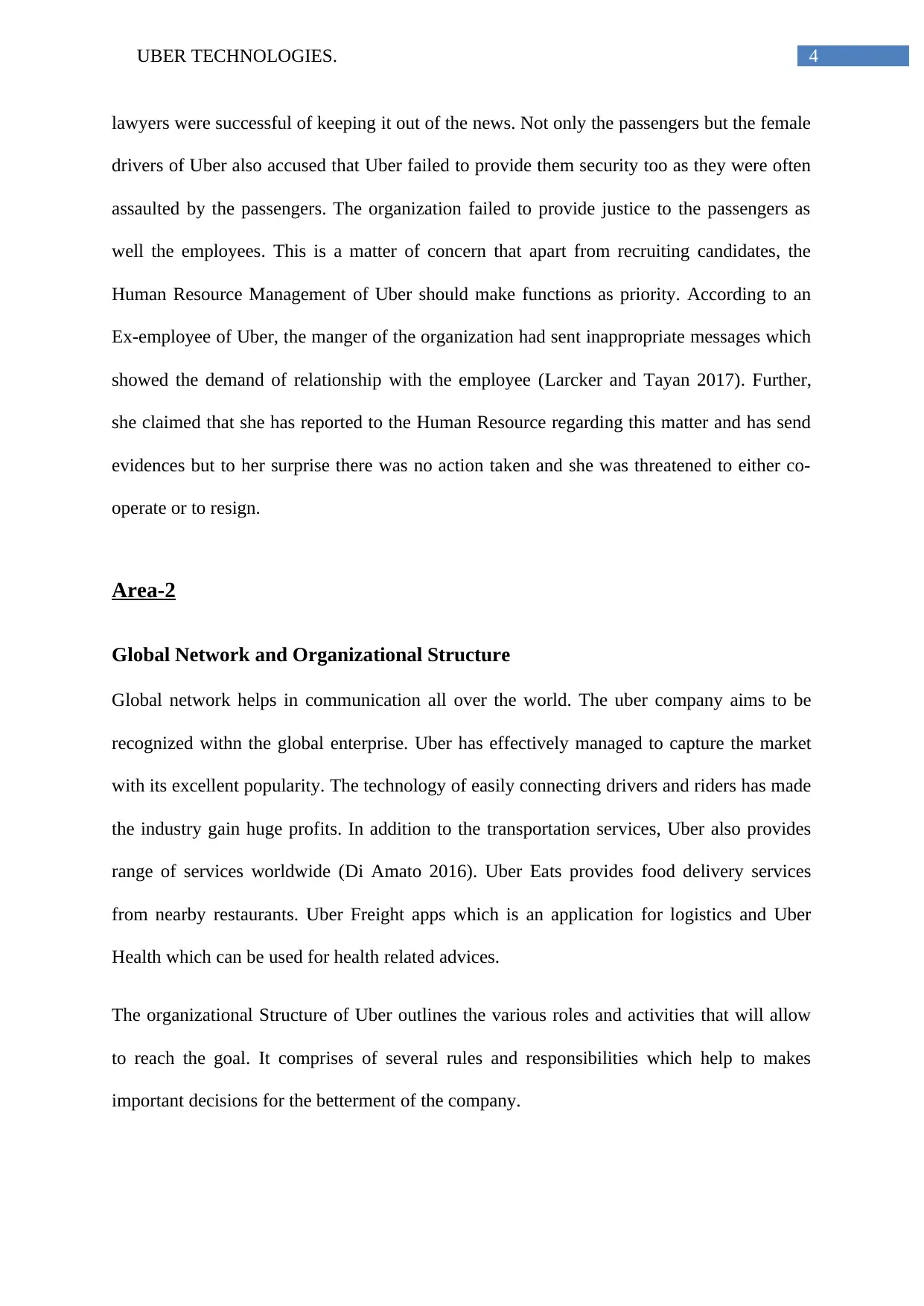
4UBER TECHNOLOGIES.
lawyers were successful of keeping it out of the news. Not only the passengers but the female
drivers of Uber also accused that Uber failed to provide them security too as they were often
assaulted by the passengers. The organization failed to provide justice to the passengers as
well the employees. This is a matter of concern that apart from recruiting candidates, the
Human Resource Management of Uber should make functions as priority. According to an
Ex-employee of Uber, the manger of the organization had sent inappropriate messages which
showed the demand of relationship with the employee (Larcker and Tayan 2017). Further,
she claimed that she has reported to the Human Resource regarding this matter and has send
evidences but to her surprise there was no action taken and she was threatened to either co-
operate or to resign.
Area-2
Global Network and Organizational Structure
Global network helps in communication all over the world. The uber company aims to be
recognized withn the global enterprise. Uber has effectively managed to capture the market
with its excellent popularity. The technology of easily connecting drivers and riders has made
the industry gain huge profits. In addition to the transportation services, Uber also provides
range of services worldwide (Di Amato 2016). Uber Eats provides food delivery services
from nearby restaurants. Uber Freight apps which is an application for logistics and Uber
Health which can be used for health related advices.
The organizational Structure of Uber outlines the various roles and activities that will allow
to reach the goal. It comprises of several rules and responsibilities which help to makes
important decisions for the betterment of the company.
lawyers were successful of keeping it out of the news. Not only the passengers but the female
drivers of Uber also accused that Uber failed to provide them security too as they were often
assaulted by the passengers. The organization failed to provide justice to the passengers as
well the employees. This is a matter of concern that apart from recruiting candidates, the
Human Resource Management of Uber should make functions as priority. According to an
Ex-employee of Uber, the manger of the organization had sent inappropriate messages which
showed the demand of relationship with the employee (Larcker and Tayan 2017). Further,
she claimed that she has reported to the Human Resource regarding this matter and has send
evidences but to her surprise there was no action taken and she was threatened to either co-
operate or to resign.
Area-2
Global Network and Organizational Structure
Global network helps in communication all over the world. The uber company aims to be
recognized withn the global enterprise. Uber has effectively managed to capture the market
with its excellent popularity. The technology of easily connecting drivers and riders has made
the industry gain huge profits. In addition to the transportation services, Uber also provides
range of services worldwide (Di Amato 2016). Uber Eats provides food delivery services
from nearby restaurants. Uber Freight apps which is an application for logistics and Uber
Health which can be used for health related advices.
The organizational Structure of Uber outlines the various roles and activities that will allow
to reach the goal. It comprises of several rules and responsibilities which help to makes
important decisions for the betterment of the company.
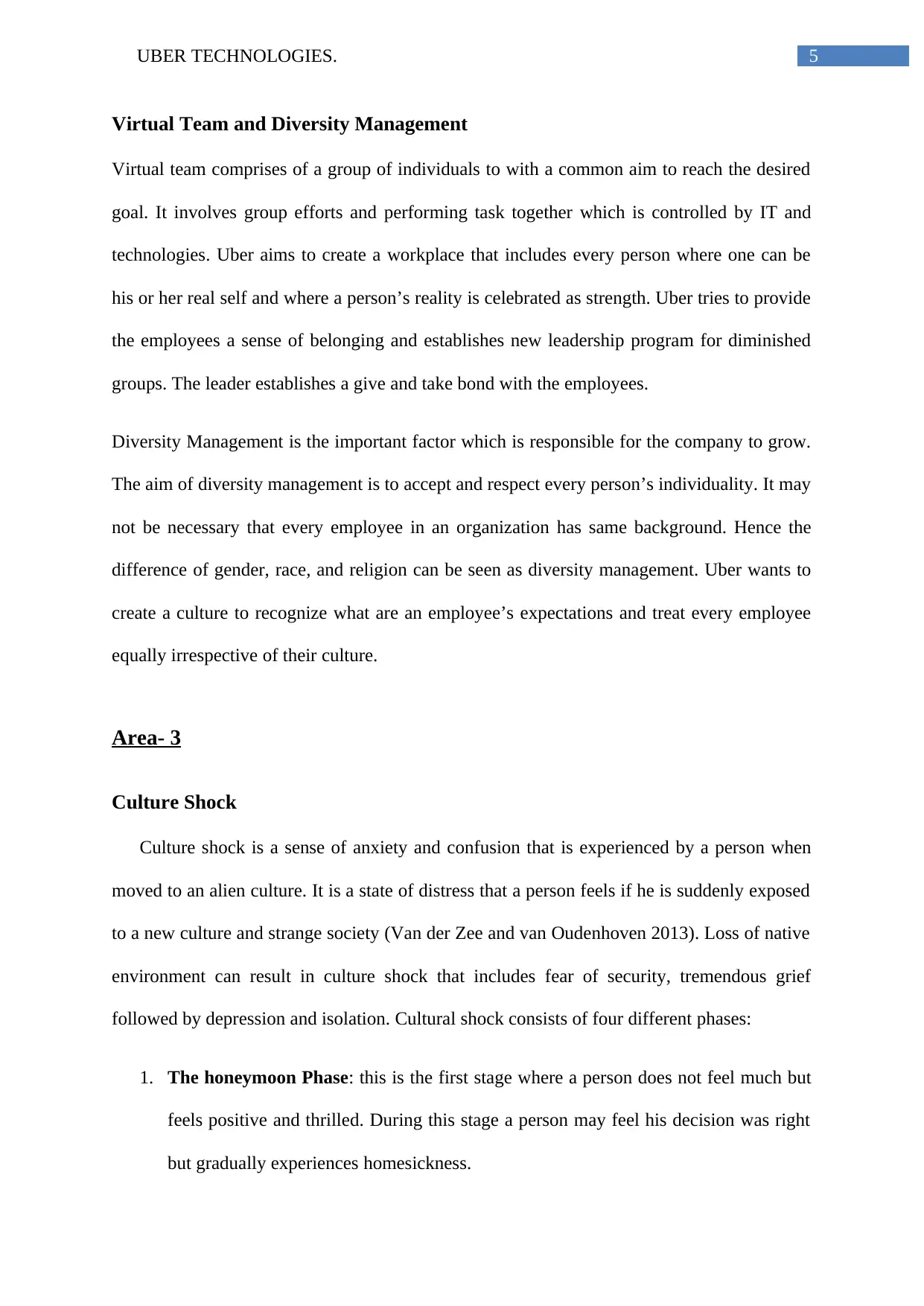
5UBER TECHNOLOGIES.
Virtual Team and Diversity Management
Virtual team comprises of a group of individuals to with a common aim to reach the desired
goal. It involves group efforts and performing task together which is controlled by IT and
technologies. Uber aims to create a workplace that includes every person where one can be
his or her real self and where a person’s reality is celebrated as strength. Uber tries to provide
the employees a sense of belonging and establishes new leadership program for diminished
groups. The leader establishes a give and take bond with the employees.
Diversity Management is the important factor which is responsible for the company to grow.
The aim of diversity management is to accept and respect every person’s individuality. It may
not be necessary that every employee in an organization has same background. Hence the
difference of gender, race, and religion can be seen as diversity management. Uber wants to
create a culture to recognize what are an employee’s expectations and treat every employee
equally irrespective of their culture.
Area- 3
Culture Shock
Culture shock is a sense of anxiety and confusion that is experienced by a person when
moved to an alien culture. It is a state of distress that a person feels if he is suddenly exposed
to a new culture and strange society (Van der Zee and van Oudenhoven 2013). Loss of native
environment can result in culture shock that includes fear of security, tremendous grief
followed by depression and isolation. Cultural shock consists of four different phases:
1. The honeymoon Phase: this is the first stage where a person does not feel much but
feels positive and thrilled. During this stage a person may feel his decision was right
but gradually experiences homesickness.
Virtual Team and Diversity Management
Virtual team comprises of a group of individuals to with a common aim to reach the desired
goal. It involves group efforts and performing task together which is controlled by IT and
technologies. Uber aims to create a workplace that includes every person where one can be
his or her real self and where a person’s reality is celebrated as strength. Uber tries to provide
the employees a sense of belonging and establishes new leadership program for diminished
groups. The leader establishes a give and take bond with the employees.
Diversity Management is the important factor which is responsible for the company to grow.
The aim of diversity management is to accept and respect every person’s individuality. It may
not be necessary that every employee in an organization has same background. Hence the
difference of gender, race, and religion can be seen as diversity management. Uber wants to
create a culture to recognize what are an employee’s expectations and treat every employee
equally irrespective of their culture.
Area- 3
Culture Shock
Culture shock is a sense of anxiety and confusion that is experienced by a person when
moved to an alien culture. It is a state of distress that a person feels if he is suddenly exposed
to a new culture and strange society (Van der Zee and van Oudenhoven 2013). Loss of native
environment can result in culture shock that includes fear of security, tremendous grief
followed by depression and isolation. Cultural shock consists of four different phases:
1. The honeymoon Phase: this is the first stage where a person does not feel much but
feels positive and thrilled. During this stage a person may feel his decision was right
but gradually experiences homesickness.
⊘ This is a preview!⊘
Do you want full access?
Subscribe today to unlock all pages.

Trusted by 1+ million students worldwide
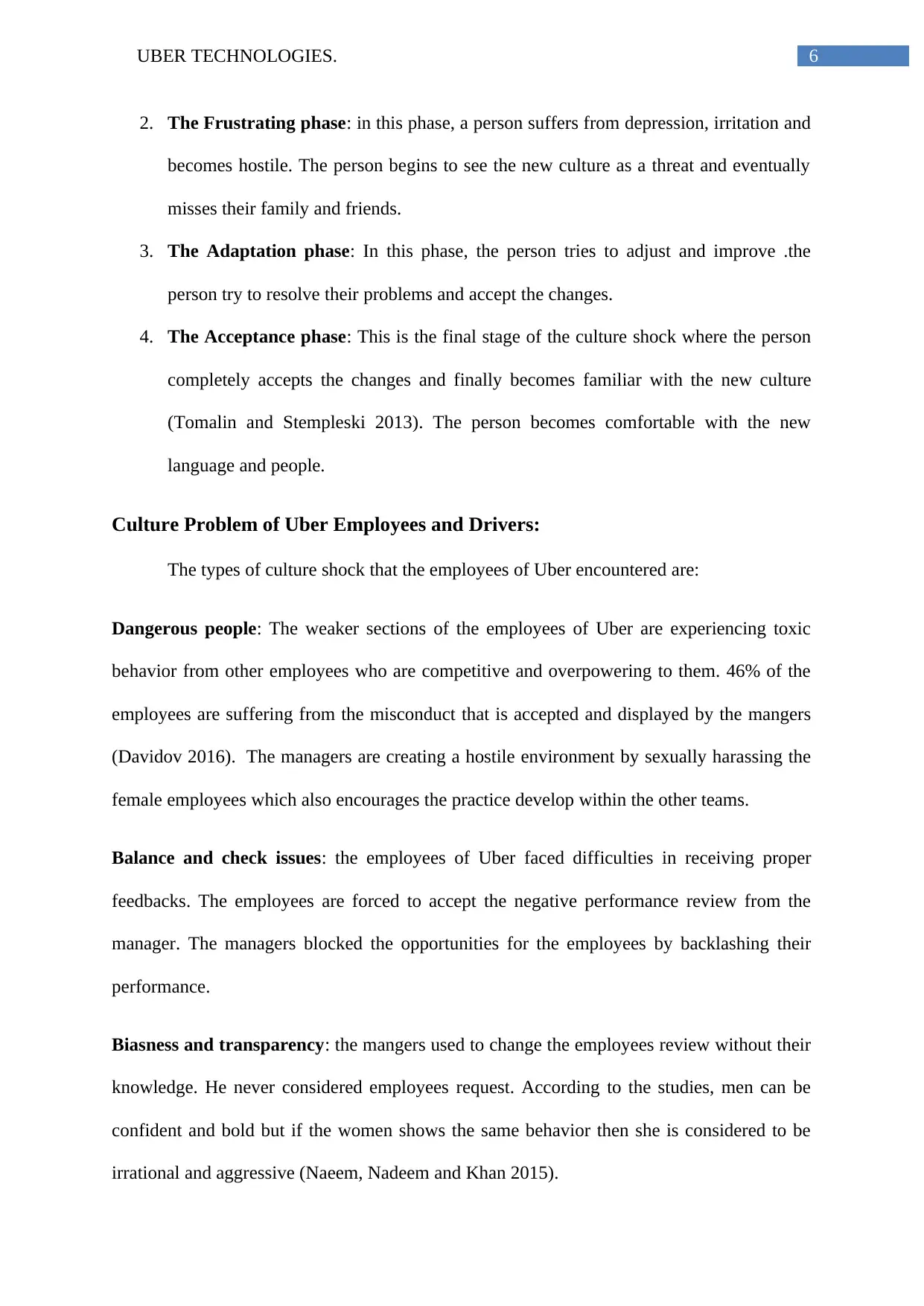
6UBER TECHNOLOGIES.
2. The Frustrating phase: in this phase, a person suffers from depression, irritation and
becomes hostile. The person begins to see the new culture as a threat and eventually
misses their family and friends.
3. The Adaptation phase: In this phase, the person tries to adjust and improve .the
person try to resolve their problems and accept the changes.
4. The Acceptance phase: This is the final stage of the culture shock where the person
completely accepts the changes and finally becomes familiar with the new culture
(Tomalin and Stempleski 2013). The person becomes comfortable with the new
language and people.
Culture Problem of Uber Employees and Drivers:
The types of culture shock that the employees of Uber encountered are:
Dangerous people: The weaker sections of the employees of Uber are experiencing toxic
behavior from other employees who are competitive and overpowering to them. 46% of the
employees are suffering from the misconduct that is accepted and displayed by the mangers
(Davidov 2016). The managers are creating a hostile environment by sexually harassing the
female employees which also encourages the practice develop within the other teams.
Balance and check issues: the employees of Uber faced difficulties in receiving proper
feedbacks. The employees are forced to accept the negative performance review from the
manager. The managers blocked the opportunities for the employees by backlashing their
performance.
Biasness and transparency: the mangers used to change the employees review without their
knowledge. He never considered employees request. According to the studies, men can be
confident and bold but if the women shows the same behavior then she is considered to be
irrational and aggressive (Naeem, Nadeem and Khan 2015).
2. The Frustrating phase: in this phase, a person suffers from depression, irritation and
becomes hostile. The person begins to see the new culture as a threat and eventually
misses their family and friends.
3. The Adaptation phase: In this phase, the person tries to adjust and improve .the
person try to resolve their problems and accept the changes.
4. The Acceptance phase: This is the final stage of the culture shock where the person
completely accepts the changes and finally becomes familiar with the new culture
(Tomalin and Stempleski 2013). The person becomes comfortable with the new
language and people.
Culture Problem of Uber Employees and Drivers:
The types of culture shock that the employees of Uber encountered are:
Dangerous people: The weaker sections of the employees of Uber are experiencing toxic
behavior from other employees who are competitive and overpowering to them. 46% of the
employees are suffering from the misconduct that is accepted and displayed by the mangers
(Davidov 2016). The managers are creating a hostile environment by sexually harassing the
female employees which also encourages the practice develop within the other teams.
Balance and check issues: the employees of Uber faced difficulties in receiving proper
feedbacks. The employees are forced to accept the negative performance review from the
manager. The managers blocked the opportunities for the employees by backlashing their
performance.
Biasness and transparency: the mangers used to change the employees review without their
knowledge. He never considered employees request. According to the studies, men can be
confident and bold but if the women shows the same behavior then she is considered to be
irrational and aggressive (Naeem, Nadeem and Khan 2015).
Paraphrase This Document
Need a fresh take? Get an instant paraphrase of this document with our AI Paraphraser
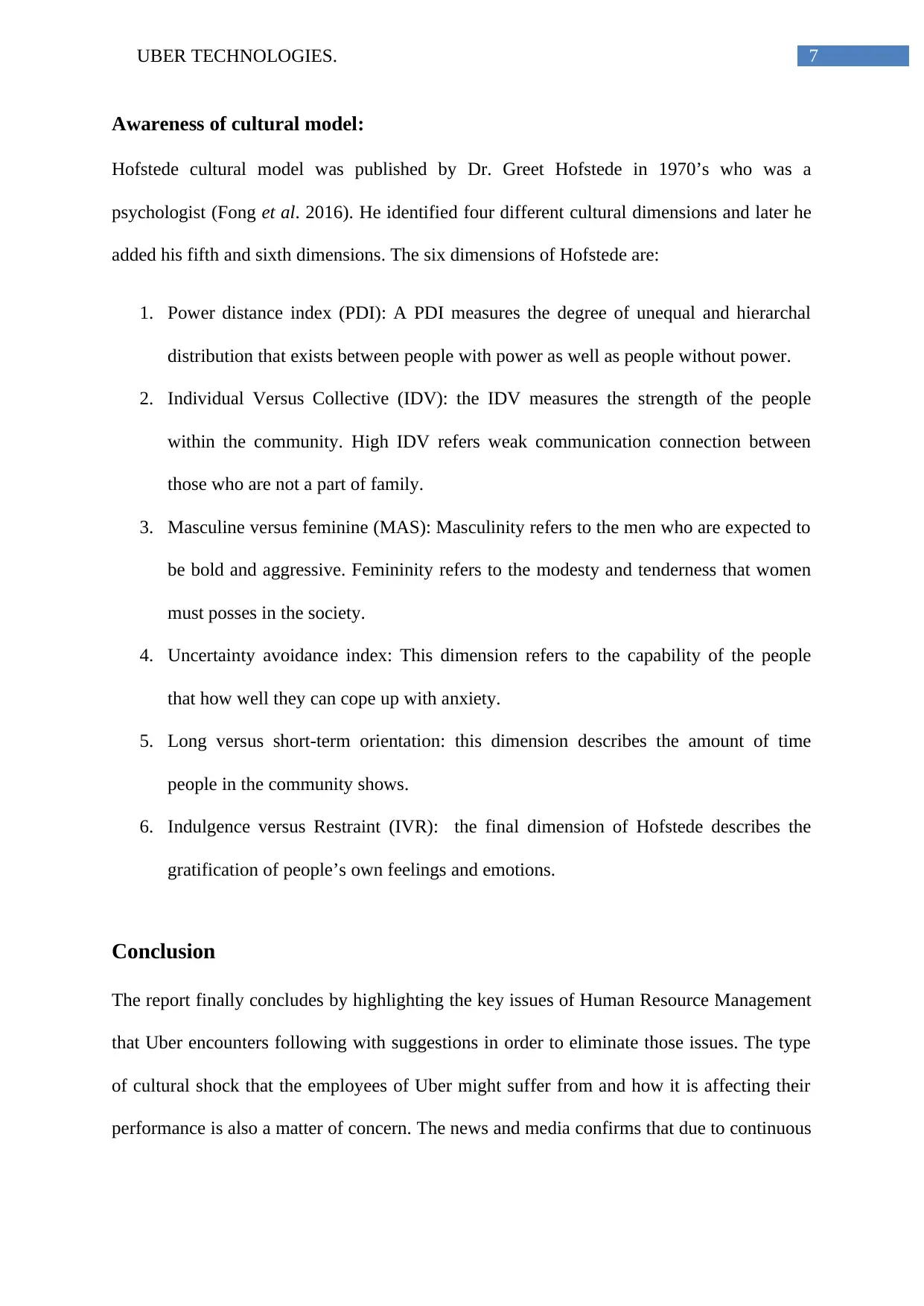
7UBER TECHNOLOGIES.
Awareness of cultural model:
Hofstede cultural model was published by Dr. Greet Hofstede in 1970’s who was a
psychologist (Fong et al. 2016). He identified four different cultural dimensions and later he
added his fifth and sixth dimensions. The six dimensions of Hofstede are:
1. Power distance index (PDI): A PDI measures the degree of unequal and hierarchal
distribution that exists between people with power as well as people without power.
2. Individual Versus Collective (IDV): the IDV measures the strength of the people
within the community. High IDV refers weak communication connection between
those who are not a part of family.
3. Masculine versus feminine (MAS): Masculinity refers to the men who are expected to
be bold and aggressive. Femininity refers to the modesty and tenderness that women
must posses in the society.
4. Uncertainty avoidance index: This dimension refers to the capability of the people
that how well they can cope up with anxiety.
5. Long versus short-term orientation: this dimension describes the amount of time
people in the community shows.
6. Indulgence versus Restraint (IVR): the final dimension of Hofstede describes the
gratification of people’s own feelings and emotions.
Conclusion
The report finally concludes by highlighting the key issues of Human Resource Management
that Uber encounters following with suggestions in order to eliminate those issues. The type
of cultural shock that the employees of Uber might suffer from and how it is affecting their
performance is also a matter of concern. The news and media confirms that due to continuous
Awareness of cultural model:
Hofstede cultural model was published by Dr. Greet Hofstede in 1970’s who was a
psychologist (Fong et al. 2016). He identified four different cultural dimensions and later he
added his fifth and sixth dimensions. The six dimensions of Hofstede are:
1. Power distance index (PDI): A PDI measures the degree of unequal and hierarchal
distribution that exists between people with power as well as people without power.
2. Individual Versus Collective (IDV): the IDV measures the strength of the people
within the community. High IDV refers weak communication connection between
those who are not a part of family.
3. Masculine versus feminine (MAS): Masculinity refers to the men who are expected to
be bold and aggressive. Femininity refers to the modesty and tenderness that women
must posses in the society.
4. Uncertainty avoidance index: This dimension refers to the capability of the people
that how well they can cope up with anxiety.
5. Long versus short-term orientation: this dimension describes the amount of time
people in the community shows.
6. Indulgence versus Restraint (IVR): the final dimension of Hofstede describes the
gratification of people’s own feelings and emotions.
Conclusion
The report finally concludes by highlighting the key issues of Human Resource Management
that Uber encounters following with suggestions in order to eliminate those issues. The type
of cultural shock that the employees of Uber might suffer from and how it is affecting their
performance is also a matter of concern. The news and media confirms that due to continuous
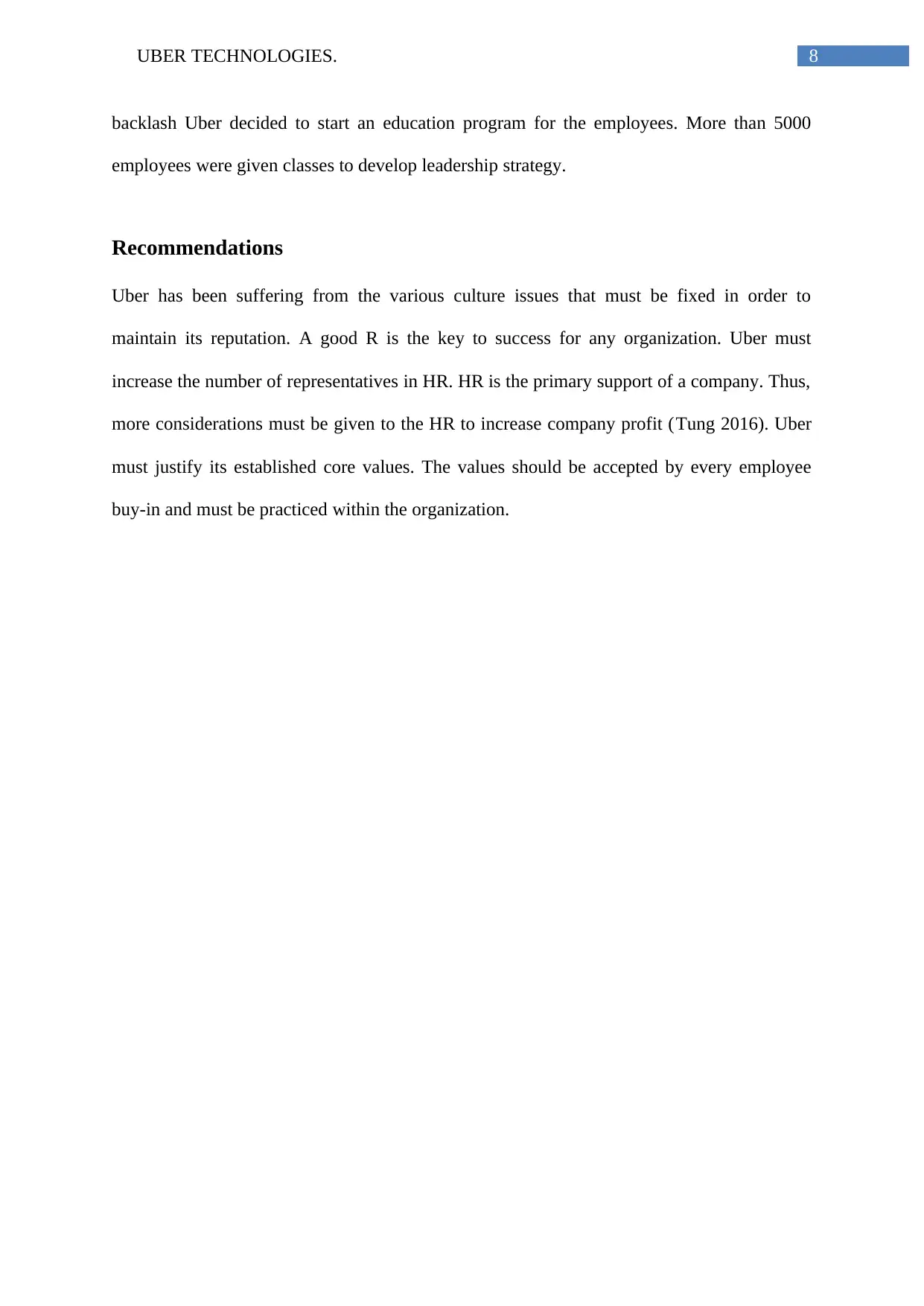
8UBER TECHNOLOGIES.
backlash Uber decided to start an education program for the employees. More than 5000
employees were given classes to develop leadership strategy.
Recommendations
Uber has been suffering from the various culture issues that must be fixed in order to
maintain its reputation. A good R is the key to success for any organization. Uber must
increase the number of representatives in HR. HR is the primary support of a company. Thus,
more considerations must be given to the HR to increase company profit (Tung 2016). Uber
must justify its established core values. The values should be accepted by every employee
buy-in and must be practiced within the organization.
backlash Uber decided to start an education program for the employees. More than 5000
employees were given classes to develop leadership strategy.
Recommendations
Uber has been suffering from the various culture issues that must be fixed in order to
maintain its reputation. A good R is the key to success for any organization. Uber must
increase the number of representatives in HR. HR is the primary support of a company. Thus,
more considerations must be given to the HR to increase company profit (Tung 2016). Uber
must justify its established core values. The values should be accepted by every employee
buy-in and must be practiced within the organization.
⊘ This is a preview!⊘
Do you want full access?
Subscribe today to unlock all pages.

Trusted by 1+ million students worldwide
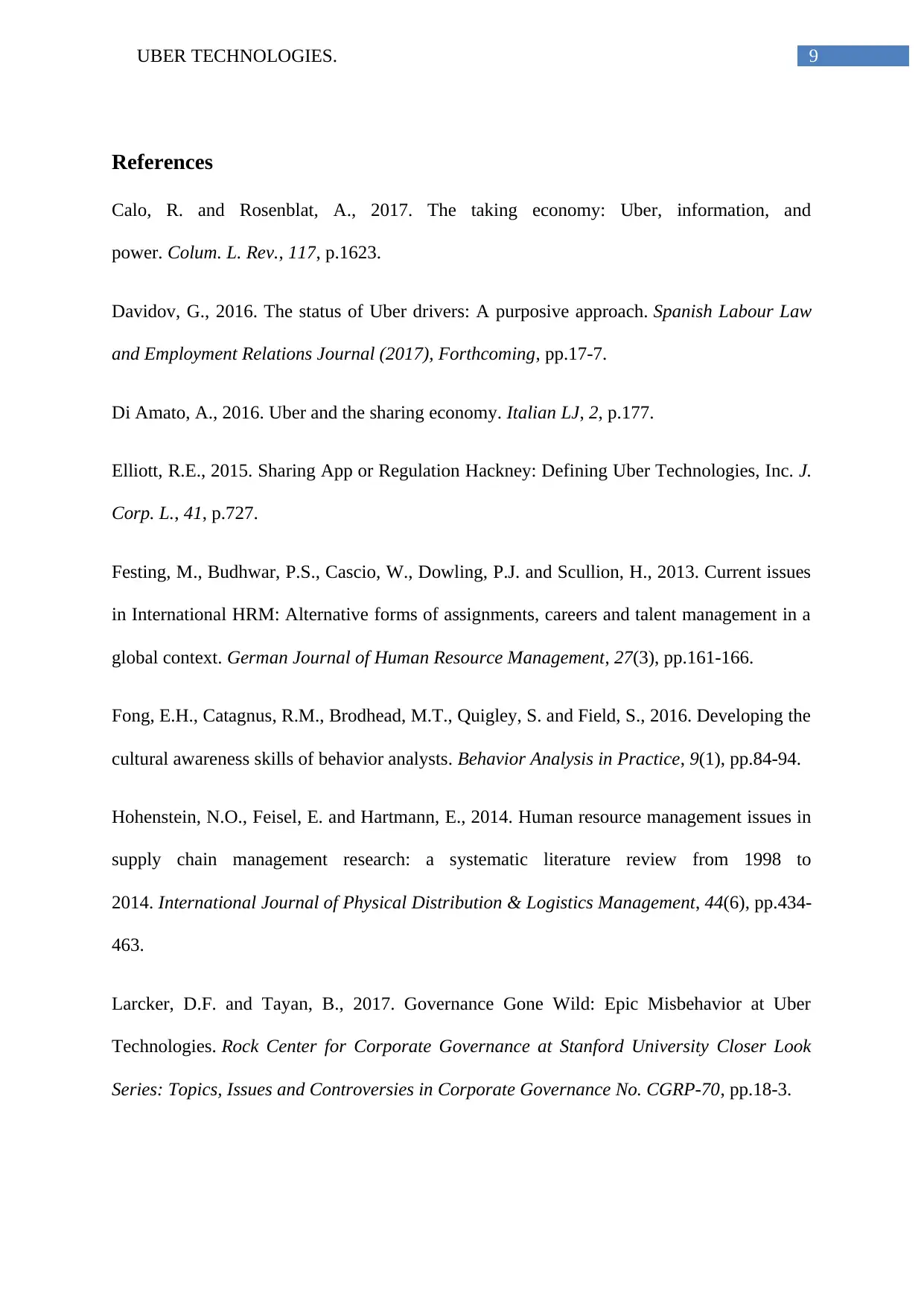
9UBER TECHNOLOGIES.
References
Calo, R. and Rosenblat, A., 2017. The taking economy: Uber, information, and
power. Colum. L. Rev., 117, p.1623.
Davidov, G., 2016. The status of Uber drivers: A purposive approach. Spanish Labour Law
and Employment Relations Journal (2017), Forthcoming, pp.17-7.
Di Amato, A., 2016. Uber and the sharing economy. Italian LJ, 2, p.177.
Elliott, R.E., 2015. Sharing App or Regulation Hackney: Defining Uber Technologies, Inc. J.
Corp. L., 41, p.727.
Festing, M., Budhwar, P.S., Cascio, W., Dowling, P.J. and Scullion, H., 2013. Current issues
in International HRM: Alternative forms of assignments, careers and talent management in a
global context. German Journal of Human Resource Management, 27(3), pp.161-166.
Fong, E.H., Catagnus, R.M., Brodhead, M.T., Quigley, S. and Field, S., 2016. Developing the
cultural awareness skills of behavior analysts. Behavior Analysis in Practice, 9(1), pp.84-94.
Hohenstein, N.O., Feisel, E. and Hartmann, E., 2014. Human resource management issues in
supply chain management research: a systematic literature review from 1998 to
2014. International Journal of Physical Distribution & Logistics Management, 44(6), pp.434-
463.
Larcker, D.F. and Tayan, B., 2017. Governance Gone Wild: Epic Misbehavior at Uber
Technologies. Rock Center for Corporate Governance at Stanford University Closer Look
Series: Topics, Issues and Controversies in Corporate Governance No. CGRP-70, pp.18-3.
References
Calo, R. and Rosenblat, A., 2017. The taking economy: Uber, information, and
power. Colum. L. Rev., 117, p.1623.
Davidov, G., 2016. The status of Uber drivers: A purposive approach. Spanish Labour Law
and Employment Relations Journal (2017), Forthcoming, pp.17-7.
Di Amato, A., 2016. Uber and the sharing economy. Italian LJ, 2, p.177.
Elliott, R.E., 2015. Sharing App or Regulation Hackney: Defining Uber Technologies, Inc. J.
Corp. L., 41, p.727.
Festing, M., Budhwar, P.S., Cascio, W., Dowling, P.J. and Scullion, H., 2013. Current issues
in International HRM: Alternative forms of assignments, careers and talent management in a
global context. German Journal of Human Resource Management, 27(3), pp.161-166.
Fong, E.H., Catagnus, R.M., Brodhead, M.T., Quigley, S. and Field, S., 2016. Developing the
cultural awareness skills of behavior analysts. Behavior Analysis in Practice, 9(1), pp.84-94.
Hohenstein, N.O., Feisel, E. and Hartmann, E., 2014. Human resource management issues in
supply chain management research: a systematic literature review from 1998 to
2014. International Journal of Physical Distribution & Logistics Management, 44(6), pp.434-
463.
Larcker, D.F. and Tayan, B., 2017. Governance Gone Wild: Epic Misbehavior at Uber
Technologies. Rock Center for Corporate Governance at Stanford University Closer Look
Series: Topics, Issues and Controversies in Corporate Governance No. CGRP-70, pp.18-3.
Paraphrase This Document
Need a fresh take? Get an instant paraphrase of this document with our AI Paraphraser
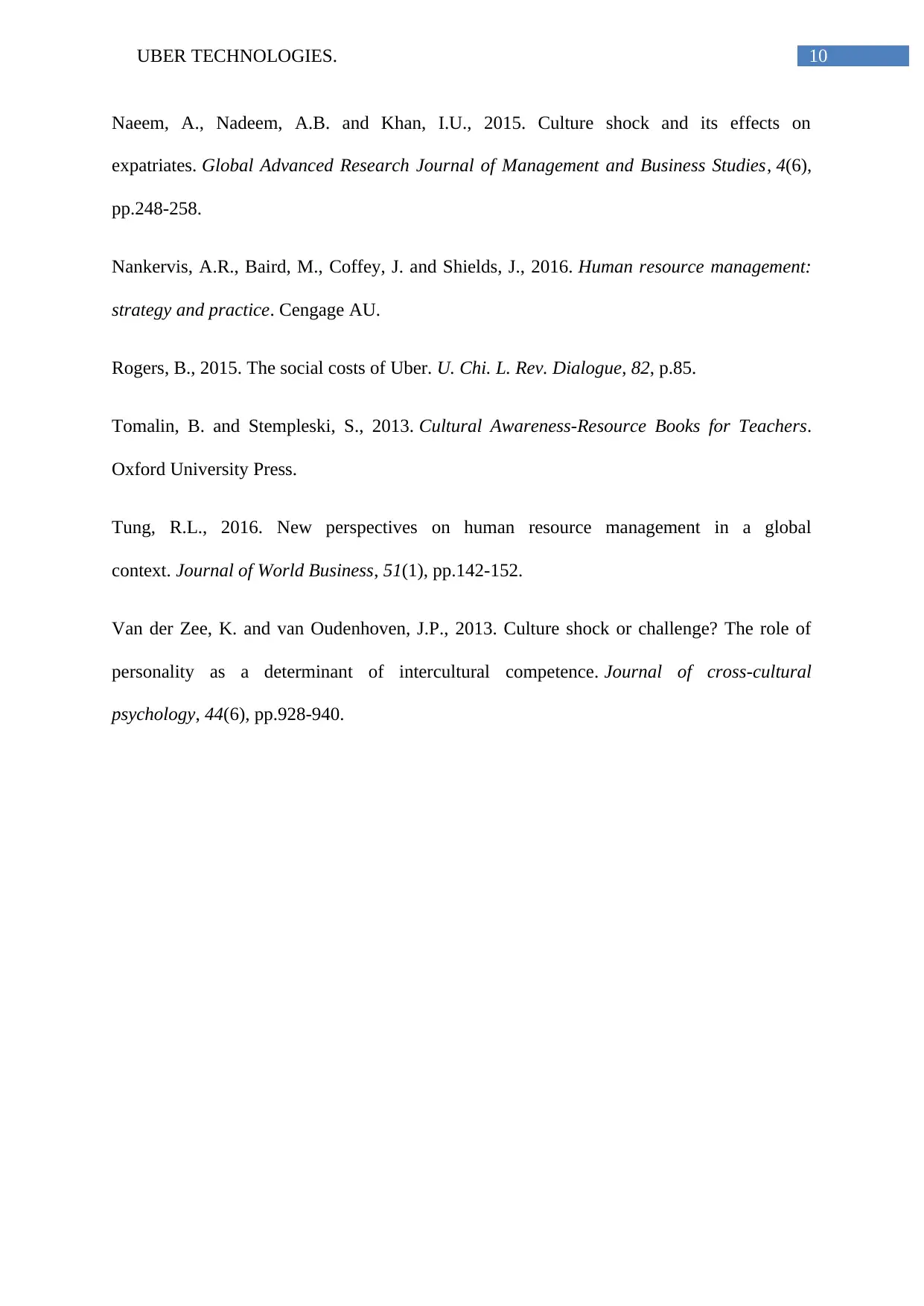
10UBER TECHNOLOGIES.
Naeem, A., Nadeem, A.B. and Khan, I.U., 2015. Culture shock and its effects on
expatriates. Global Advanced Research Journal of Management and Business Studies, 4(6),
pp.248-258.
Nankervis, A.R., Baird, M., Coffey, J. and Shields, J., 2016. Human resource management:
strategy and practice. Cengage AU.
Rogers, B., 2015. The social costs of Uber. U. Chi. L. Rev. Dialogue, 82, p.85.
Tomalin, B. and Stempleski, S., 2013. Cultural Awareness-Resource Books for Teachers.
Oxford University Press.
Tung, R.L., 2016. New perspectives on human resource management in a global
context. Journal of World Business, 51(1), pp.142-152.
Van der Zee, K. and van Oudenhoven, J.P., 2013. Culture shock or challenge? The role of
personality as a determinant of intercultural competence. Journal of cross-cultural
psychology, 44(6), pp.928-940.
Naeem, A., Nadeem, A.B. and Khan, I.U., 2015. Culture shock and its effects on
expatriates. Global Advanced Research Journal of Management and Business Studies, 4(6),
pp.248-258.
Nankervis, A.R., Baird, M., Coffey, J. and Shields, J., 2016. Human resource management:
strategy and practice. Cengage AU.
Rogers, B., 2015. The social costs of Uber. U. Chi. L. Rev. Dialogue, 82, p.85.
Tomalin, B. and Stempleski, S., 2013. Cultural Awareness-Resource Books for Teachers.
Oxford University Press.
Tung, R.L., 2016. New perspectives on human resource management in a global
context. Journal of World Business, 51(1), pp.142-152.
Van der Zee, K. and van Oudenhoven, J.P., 2013. Culture shock or challenge? The role of
personality as a determinant of intercultural competence. Journal of cross-cultural
psychology, 44(6), pp.928-940.
1 out of 11
Related Documents
Your All-in-One AI-Powered Toolkit for Academic Success.
+13062052269
info@desklib.com
Available 24*7 on WhatsApp / Email
![[object Object]](/_next/static/media/star-bottom.7253800d.svg)
Unlock your academic potential
Copyright © 2020–2025 A2Z Services. All Rights Reserved. Developed and managed by ZUCOL.





